Evaluation the effects of low-level laser therapy on disc displacement with reduction
2 Department of Prosthodontic, Van Yüzüncü Yıl University, Faculty of Dentistry, Van, Turkey
3 Department of Periodontology, Van Yüzüncü Yıl University, Faculty of Dentistry, Van, Turkey DOI : 10.5606/tftrd.2020.3355 Objectives: This study aims to evaluate the effects of additional low-level laser therapy (940 nm GaAlAs) to the routine occlusal splint therapy on maximal mouth opening (MMO), visual analog scale (VAS) scores, and passive mouth opening (PMO).
Patients and methods: Between January 2016 and March 2018, a total of 40 patients (10 males, 30 females; mean age 22.35 years; range, 18 to 60 years) with disc displacement with reduction of the temporomandibular joint were included. The patients were divided into two groups. Group 1 (control group, n=20) received routine non-steroidal anti-inflammatory drug (NSAID) therapy and occlusal splint therapy for eight hours per day for a total of three months. Group 2 (laser group, n=20) received NSAID, occlusal splint therapy and 940 nm wavelength diode laser therapy for two sessions per week for a total of four weeks. The MMO, PMO, and VAS scores were recorded before and at one, two, three, four, and 12 weeks after treatment. The joint and muscle examinations were performed.
Results: A constant decrease was found in the VAS scores in both groups. At four (p=0.008) and 12 weeks (p=0.003), a statistically significant difference in the VAS scores was observed. At all time points, PMO and MMO scores increased in both groups. The MMO scores were statistically higher in the laser group at all time points (p<0.005).
Conclusion: Our study results suggest that short-term low-level laser therapy additional to conventional treatment may yield satisfactory outcomes.
Keywords : Low-level laser therapy, occlusal splint, temporomandibular disorders

















